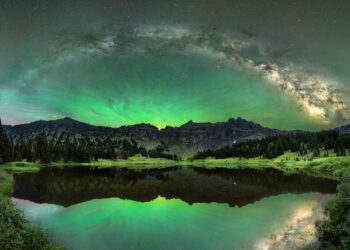By Amanda Monthei EBS Contributor
Wildfires are a fact of life in the American West — as of Aug. 1, some 39,000 wildfires have burned almost 5.5 million acres, a collection of land about the size of New Jersey. August marks the pinnacle of fire starts and large-scale wildfires in the Northern Rockies, as fuels are at their driest and precipitation levels dip to their lowest.
Many people, especially those living in fire-prone areas, know how wildfires begin— whether it’s lightning striking tinder-dry timber or a campfire left to smolder and ignite nearby leaf litter, fire starts are generally a result of either carelessness or the passage of lightning.
How those fires are managed and contained, however, is a lesser-known phenomenon which depends on factors ranging from vegetation types and terrain to the decisions of the fire’s incident commander. Below are some lesser-known aspects of fire suppression.

Mobilization
When fires are first spotted, they are called into a local dispatch center, which then takes an inventory of the local resources (engines, crews or helicopters) available to respond to the fire.
A new incident that is small and manageable on a local level is called an initial attack fire. Most fires are contained and controlled at this level, requiring very few resources over only one or two operational shifts. These incidents vary in size, but are generally smaller than 50 acres. The majority of these fires are incredibly small, sometimes just a single tree that was struck by lightning.
Extended attack fires are slightly larger and often more complex—perhaps structures are threatened, or steep terrain and heavy fuels complicate containment efforts. Extended attack fires and large-scale, headline-making fires are handled by a geographic coordinating center for a specific region, or by the National Interagency Fire Center based in Boise, Idaho.
NIFC prioritizes incidents based on infrastructure, structures or communities at risk, mobilization time, and financial or geographic factors to determine which crews, engines or helicopters go where.
Resources
What could a crew of 20 people possibly do to help contain a 2,000-, 10,000- or 50,000-acre fire? This was one of my biggest questions when I started to pursue wildland firefighting, and come to find out, there’s quite a bit we can do to thwart the progress of a fire, regardless of size.
Hand crews have a variety of responsibilities, but their primary task is to dig line. Digging line creates a fuel break, as firefighters use hand tools to dig a 12- to 24- inch fireline all the way to mineral soil, preventing the fire from continuing to spread along ground fuels.
Where timber is concerned, however, different tactics must be used to control a fire— namely, burning out or requesting water and retardant drops from aircraft. To burn out, firefighters use drip torches and other ignition tools to start a fire along the line. The purpose is to eliminate all fuel between the line and the approaching fire, which will die out once it reaches trees and brush that have already burned.
Aircraft like helicopters and air tankers are also a massive contributor to the success of wildfire suppression, as they not only have the capability to fly crews in and out of remote fires, but can also drop anywhere from 200 to a couple thousand gallons of water or retardant on areas of a fire either inaccessible or too extreme for engines or crews to engage in.
Finally, engines are used when the fire is reasonably accessible by road (even logging roads or two-tracks). Engines carry hundreds of gallons of water to remote areas and, once there, engine crews can set up hose to reach areas of the fire that are far from the road.
Contained or controlled?
If you’ve ever read a news story about a wildfire, you’ve likely seen containment numbers. A fire is considered contained when there’s a line constructed around the perimeter of the fire that will not allow it to spread any further. A fire is considered controlled when that containment line has been determined to be capable of “holding” the fire after crews have left.
But a lot more goes into the containment and control of a fire than one would expect. Containment requires that crews have begun “mopping up,” or gridding the fire area for smoke or hot spots that might undermine the control line if left unattended. Mopping up is a tedious but important task that can last for weeks on large fires. It involves extinguishing smoking material and residual heat to ensure that the fire doesn’t throw an ember or flare up again.
For many fire crews, mopping up makes up nearly 80 percent of their time on the fireline. However dirty and unglamorous, it’s a necessary part of fire suppression.
Amanda Monthei is a wildland firefighter by summer and a freelance writer and odd-job connoisseur the rest of the year. While originally from Michigan, she now spends her time fishing, hot-springing and smelling like smoke in the Salmon River Mountains of Idaho.













